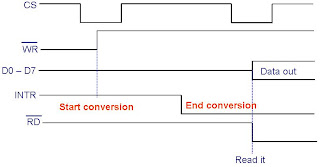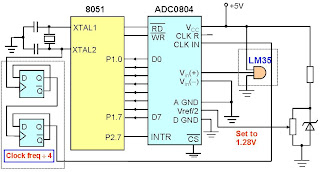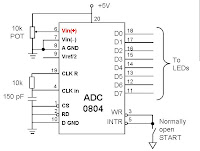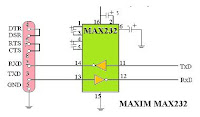Programming Aspects of Moving message display project using 8051:-
In this post we will discuss the software or program or code written for moving message display project using microcontroller 8051.
In this section, we will try to answer the issues related to the timings of the signals generated. The timing of the signal relates to the order in which an instruction or command is sent to the LCD along with the appropriate signal of control signals. For example, if the Microcontroller programmer intends to send a byte of data intended for the display screen; the programmer will follow the following pseudo code steps:
Clear R/S signal to indicate an instruction is being sent
Clear R/W signal to indicate writing to the LCD is being intended
Move data to the data lines
Set Bit EN signal and then Clear EN to indicate that data intended to the LCD is present on the connecting interface latch
Check for Busy Flag to be set to logic zero. This to ensure that when next time data is to be sent to the LCD module, the LCD is not in the middle of performing any internal operations [4].
5.1 Code Overview
In this section, we will discuss some of the important sections of the code written for the Microcontroller. The code for the convenience of the reader is produced here as well as present in the soft copy in the attached files.
BUFFER EQU 05FH ;LOCATION FOR STORAGE LCD DATA
BUFF_POINTER EQU 05EH ;LOCATION HOLDS BUFFER CURRENT POINTER
DATA_LINE EQU 090H ;WRITING TO PORT 1
ORG 0000H
LJMP MAIN
;********************SERIAL ISR**********************************
ORG 0023H
PUSH ACC
PUSH 00H
LCALL SERIAL_ISR
POP 00H
POP ACC
RETI
;****************************************************************
;LCD CONTROL SIGNALS
LCD_EN EQU 0B7H
LCD_RW EQU 0B6H
LCD_RS EQU 0B5H
;LCD CONFIGURATIONS COMMANDS
FNC_SET EQU 38H ;8 BIT ,2 LINE , 5X7 MATRIX
ENT_MOD EQU 06H
;DIFFERENT SETTINGS OF BLINK,DISPLAY AND CURSOR ON/OFF
DOF_COF_BOF EQU 08H
DOF_COF_BON EQU 09H
DOF_CON_BOF EQU 0AH
DOF_CON_BON EQU 0BH
DON_COF_BOF EQU 0CH
DON_COF_BON EQU 0DH
DON_CON_BOF EQU 0EH
DON_CON_BON EQU 0FH
CLR_DISP EQU 01H
HOME_CUR EQU 02H
;DIFFERENT SETTING OF CURSOR/DISPLAY SHIFT RIGHT/LEFT
CUR_L EQU 10H
CUR_R EQU 14H
DISP_L EQU 18H
DISP_R EQU 1CH
;**************************************************************
MAIN:
MOV R0,#BUFF_POINTER
MOV @R0,#BUFFER ;STORE THE INTIAL POINT OF WRITING STRING
;START TIMER 1 FOR BAUD RATE GENERATION
MOV TMOD,#21H
MOV TH1,#-26
MOV TL1,#-26
SETB TR1
MOV SCON,#50H ;INIT THE SERIAL PORT FOR RECEPTION
MOV IE,#90H ;ENABLE SERIAL INTERUPT
MOV P1,#0H
MOV P3,#0H
MOV R0,#BUFFER+1
MOV @R0,#'A'
INC R0
MOV @R0,#'B'
INC R0
MOV @R0,#'C'
INC R0
MOV @R0,#0H
MOV R7,#1H ;100 ;SET DELAY TIMER
;LCALL DELAY
;LCALL INIT
LCALL PRINT_STR
SJMP $
;*************************** DELAY ROUTINE *************************
;THE ROUTINE PRODUCES A DELAY OF 10 msec
;VALUE EXPECTED IN R7, FOR NUMBER OF TIMES
;TO RUN THIS FUNCTION
DELAY:
AGAIN:
MOV TH0,#HIGH(-10000)
MOV TL0,#LOW(-10000)
SETB TR0
JNB TF0,$
CLR TF0
CLR TR0
DJNZ R7,AGAIN
RET
;********************************************************************
;******************INITIALIZATION AND RESEST ROUTINE FOR LCD********
INIT:
CLR LCD_EN
CLR LCD_RW
CLR LCD_RS
MOV R7,#FNC_SET ;WRITING FUNCTION SET TO LCD
LCALL WRITE_LCD_INST
MOV R7,#01H ;GIVE 10MS DELAY
MOV R7,#FNC_SET ;WRITING FUNCTION SET TO LCD
LCALL WRITE_LCD_INST
MOV R7,#01H ;GIVE 10MS DELAY
MOV R7,#FNC_SET ;WRITING FUNCTION SET TO LCD
LCALL WRITE_LCD_INST
MOV R7,#01H ;GIVE 10MS DELAY
MOV R7,#DOF_COF_BOF
LCALL WRITE_LCD_INST
MOV R7,#DON_CON_BOF
LCALL WRITE_LCD_INST
MOV R7,#CLR_DISP
LCALL WRITE_LCD_INST
MOV R7,#ENT_MOD
LCALL WRITE_LCD_INST
RET
;*********************************************************************
;*********************WRITING COMMANDS TO LCD*************************
;THE COMMAND TO BE SENT IS PLACED IN R7
WRITE_LCD_INST:
CLR LCD_EN
CLR LCD_RS
CLR LCD_RW
MOV DATA_LINE,R7
SETB LCD_EN
CLR LCD_EN
LCALL CHK_BZ_FLAG
MOV R7,#02H
RET
;*************************************************************
;****************************************************************
;******CHECKS FOR BUSY FLAG FOR THE LCD*******************
;READS LCD STATUS AND CHECKS BZ FLAG IN MSB OF DATA_LINE
CHK_BZ_FLAG:
CLR LCD_EN
SETB LCD_EN
CLR LCD_EN
MOV DATA_LINE,#0FFH ;TO CONFIGUREPORT TO READ INPUT
SETB LCD_RW
PUSH ACC
CHK_PULSE:
SETB LCD_EN
MOV A,DATA_LINE
CLR LCD_EN
JB ACC.7,CHK_PULSE
POP ACC
CLR LCD_RW
RET
;**************************************************************************
;************************WRITING DATA TO LCD*******************************
;WRITES DATA TO LCD. ACCEPTS DATATO BE SENT IN R7
WRITE_LCD_DATA:
CLR LCD_EN
SETB LCD_RS
CLR LCD_RW
MOV DATA_LINE,R7
SETB LCD_EN
CLR LCD_EN
CLR LCD_RS
LCALL CHK_BZ_FLAG
RET
;**************************************************************************
;*********************PRINTS THE CONTENTS OF BUFFER************************
;bUFFER LOCATION HOLDS THE STRING TO BE TRANSMITTED,IT IS 0 TERMINATED
PRINT_STR:
MOV R0,#BUFFER+1
PRINT_NEXT:
CJNE @R0,#30H,PRINT
SJMP END_STR
PRINT:
MOV A,@R0
MOV R7,A
LCALL WRITE_LCD_DATA
INC R0
SJMP PRINT_NEXT
END_STR:
RET
;************************************************************************
;*************************SERIAL ISR HANDLER*****************************
SERIAL_ISR:
CLR RI
MOV A,SBUF
CJNE A,#30H,STORE_VALUE
MOV R0,BUFF_POINTER
MOV @R0,#0H
LCALL PRINT_STR ;PRINTS THE RECIVED STRING
RET
STORE_VALUE:
MOV R0,BUFF_POINTER
MOV @R0,A
INC R0
MOV BUFF_POINTER,R0
RET
END
Tags:-
Programming Aspects of Moving message display project using 8051,assembly language program for lcd,software named Proteus 7 for simulating the working of our project,8051software ,8051 Software, C Compilers, Basic Editor, and Chip Simulator, PC-based programs, and a development board ,develop your 8051-based project, 8051 Software Tools Overview,Free 8051 Tools, Code and Projects,Free 8051 microcontroller resources,Easy To Use Monitor Program, AS31 Assembler, Development Circuit Board Design, Code Library ,Code Library ,8051 Code Examples,Assembly Language Programming: 8051,Test code for 8051SBC ,An introduction to the 8051, especially programming the 8051 in C using the Keil ,8051 code, with serial port code, math functions,program ming Phillips not working with Atmel code 8051 ,Assembly code for 1sec delay for 8051 ,How to write the 8051 program to control the alarm,Programming and Interfacing the 8051 in C and Assembly,8051 program code to HD44780 ,8051 microcontroller hardware interfacing tutorials ,8051 Microprocessor Example Program,ACCESSING CODE ROM SPACE IN 8051 C,Free 8051 Microcontroller projects



















